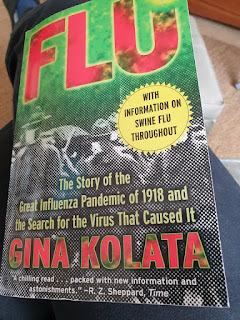In Praise of Epidemiologists and Virologists: The 1918 Spanish Flu Pandemic
Eighty-Seven Years of Research
Unlocked Some of the Mysteries of the Virus
that Killed 50 Million People Worldwide
I finished the book on the Spanish flu: "Flu: The Story of the Great Influenza Pandemic of 1918 and the Search for the Virus that Caused it" by Gina Kolata. Over the last two months, I have read books on Ebola, Cholera, the Black Plague, and malaria. My reading list still includes books on HIV, smallpox, and the risk of coming pandemics.
Scientists have learned that the virus causing the Spanish flu was genetically similar to viruses found in birds. It mutated in pigs, then infected humans.
The Spanish flu virus was probably circulating (in a less virulent form) in the population for several years before the deadly 1918 outbreak that killed 50 million worldwide. The weird mortality curve, with younger people dying at higher rates, may reflect that older people had antibodies from the 1890 flu (developed when they were baby or toddlers) that worked against it.
Scientists in the U.S. finished sequencing the genetic code in 2004 or 2005, when they finally found virus in the lung tissue of an Eskimo woman whose body had been preserved in permafrost. Preserved samples from service men who had died did not provide all the genetic fragments they needed. They also reconstructed the virus. Scientists first found genetic fragments of the virus in the late 1990s.
The Spanish flu virus was probably circulating (in a less virulent form) in the population for several years before the deadly 1918 outbreak that killed 50 million worldwide. The weird mortality curve, with younger people dying at higher rates, may reflect that older people had antibodies from the 1890 flu (developed when they were baby or toddlers) that worked against it.
Scientists in the U.S. finished sequencing the genetic code in 2004 or 2005, when they finally found virus in the lung tissue of an Eskimo woman whose body had been preserved in permafrost. Preserved samples from service men who had died did not provide all the genetic fragments they needed. They also reconstructed the virus. Scientists first found genetic fragments of the virus in the late 1990s.
The lead scientist in this story is a guy named Jeffrey Taubenberger, now the Chief of the Viral Pathogenesis and Evolution Section, Laboratory of Infectious Diseases, National Institute of Allergy and Infectious Diseases, National Institutes of Health. Ann H. Reid, then a highly skilled technician in molecular biology, played a significant role in the discoveries they made.
Scientists still have many questions about the Spanish flu. They still do not know why it was so deadly.
But, that pandemic, and near misses like the bird flu of 1997, shape the nightmares of epidemiologists and virologists. If they under-react to early warning signs, they risk a pandemic with a high death toll. If they over-react, like the 1976 swine flu vaccination program, their choices can lead to public skepticism, litigation, and adverse reactions to the vaccine.
But, it's quite clear that these professionals remain vigilant to emerging viruses and are deeply committed to public health.
One epidemiologists I am following on Twitter is David Lilienfeld.
Scientists still have many questions about the Spanish flu. They still do not know why it was so deadly.
But, that pandemic, and near misses like the bird flu of 1997, shape the nightmares of epidemiologists and virologists. If they under-react to early warning signs, they risk a pandemic with a high death toll. If they over-react, like the 1976 swine flu vaccination program, their choices can lead to public skepticism, litigation, and adverse reactions to the vaccine.
But, it's quite clear that these professionals remain vigilant to emerging viruses and are deeply committed to public health.
One epidemiologists I am following on Twitter is David Lilienfeld.




Comments
Post a Comment